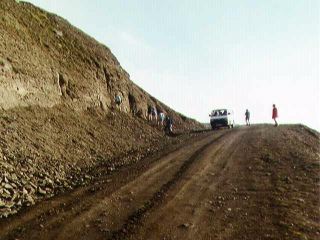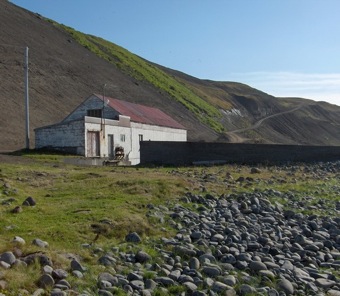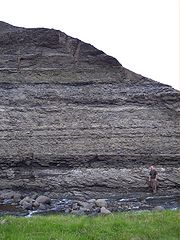|
The Fossil Museum
Did you
know that the poles of the earth have changed places several
times? The earth has "rolled over" and suddenly we are in the
tropic
climate! Do you need a proof? Visit this private
owned museum of
fossils from the Tjornes peninsula layers. You can see the
evidence at the Fossil Museum. The small one-room
museum houses a diverse collection of locally found fossils, including
petrified wood, fossilized crystalline, whale- and
shark
bones and
lignite (coal).
 The lignite was mined during the time of the
second
world war. The
lignite strata irrefutably depict the fact, that there were coniferous
forests in Iceland along with spruce, oak , beech, platan and other
species, which can not be found any more. The museum is
located
just 10 km north of Husavik. Turn left at the sign
"Hallbjarnarstadir museum" and enjoy the museum. The lignite was mined during the time of the
second
world war. The
lignite strata irrefutably depict the fact, that there were coniferous
forests in Iceland along with spruce, oak , beech, platan and other
species, which can not be found any more. The museum is
located
just 10 km north of Husavik. Turn left at the sign
"Hallbjarnarstadir museum" and enjoy the museum.Afterwards it is interesting to drive the road (close to Hallbjarnarstadir museum ) marked "Tjorneshofn". Open the gates and close after you. The very steep dirt road leads down to the beach to a small harbor. You can take the walk by the small river and look at the real fossils. Such is their rarity, that the peninsula has become a place of study for geology students from across the world. PLEASE DO NOT REMOVE ANYTHING FROM THE SITE UNLESS YOU HAVE PERMISSION FROM THE MUSEUM Tjornes is one of the best known geological localities in Iceland, famous for the fossil layers, which were formed at the end of the Tertiary period and during the Ice Age. Unlike the volcanic landscape everywhere else in Iceland, the Tjornes is sedimentary, made from layers of organic deposits that date back to the Pliocene era. When the earths crust last moved, the layers were pushed up from the sea bed. From these fossils it is possible to trace changes in climate, vegetation and marine life from the beginning of the Ice Age.  The alternating strata of
sand and deposits are either totally devoid
of any sign of life or contain compact layers from the Pliocene and the
late ice age, fossilized marine life. These strata confirm the opening
of the Bering Strait (probably at the end of the tertiary or the
beginning of the ice age), connecting the two great oceans, the Pacific
and the Atlantic.
Among the fossilized shells
are specimen from
the Pacific Ocean, which could only have traveled through the Strait
in earlier times. The alternating strata of
sand and deposits are either totally devoid
of any sign of life or contain compact layers from the Pliocene and the
late ice age, fossilized marine life. These strata confirm the opening
of the Bering Strait (probably at the end of the tertiary or the
beginning of the ice age), connecting the two great oceans, the Pacific
and the Atlantic.
Among the fossilized shells
are specimen from
the Pacific Ocean, which could only have traveled through the Strait
in earlier times.  Various theories explain how the creation of the
Bering Sea opened up the North Atlantic and how the earths shift in
magnetic poles meant that once up on a time, Iceland was
quite
warm. Various theories explain how the creation of the
Bering Sea opened up the North Atlantic and how the earths shift in
magnetic poles meant that once up on a time, Iceland was
quite
warm. These strata also show lava layers, river deposits and moraines, which depict the changes of the climate, the sea and land fauna and the flora. The thickness of this strata measures about 500 m but the total thickness amounts to about 1200 m. The oldest stratum was found between the rivers Kaldakvisl and Reka. There one can find alternating strata of lignite and sea shells. The Tjornes strata also bear witness to the different status of the sea levels and that the ice age commenced about 3000 years ago with at least 10 differently extended warm periods in-between. Such is their rarity that the peninsula has become a place of study for geology students from across the world. |